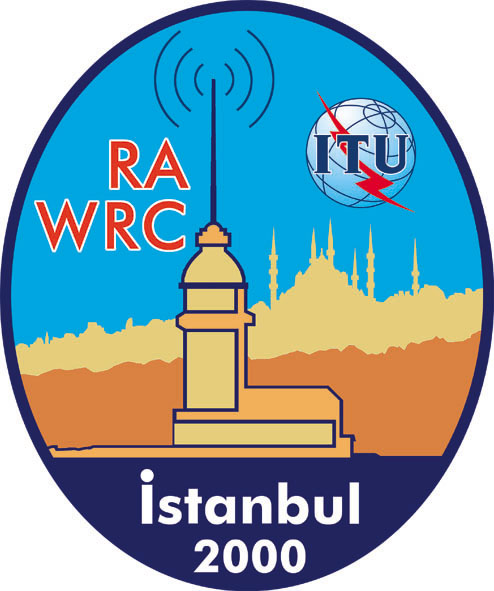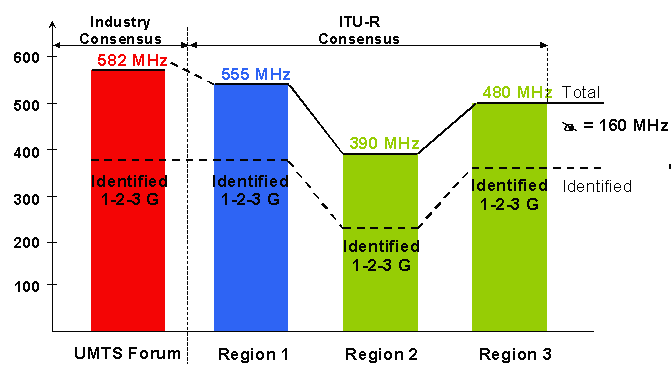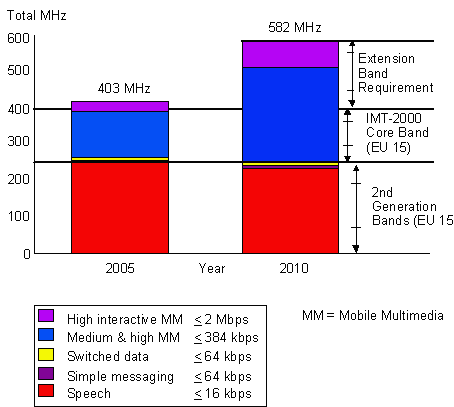
World Radiocommunication Conference 2000
Telephone: +41 22 730 6039
Fax: +41 22 730 5939
E-mail: pressinfo@itu.int
 |
World Radiocommunication Conference 2000 |
|
Telephone: +41 22 730 6039 |
IMT-2000 Spectrum — Views from the UMTS Forum
Global market forecasts for mobile services are enormous. The UMTS Forum, representing the global mobile industry, estimates that by 2010 there will be around 2 billion mobile users worldwide. Interactive multimedia services, electronic commerce, the growing penetration of personal computers (PC) at home, in the office and on the move, together with the increasing use of credit and debit cards will all drive web-based transactions to a significant level of traffic globally on both fixed and mobile networks. With IMT-2000 wireless multimedia services, up to 2 Mbit/s will be available to indoor, outdoor and vehicle-based users. Worldwide plans to introduce IMT-2000 foresee the first deployment of services from 2001. The IMT-2000 licensing process has already begun in Europe and will continue, with more than 100 licences expected worldwide by 2002. IMT-2000 will be the largest ITU project ever.
Mobility for computer-based communications and the move to IMT-2000
New developments such as the Internet, and particularly the intranet, are now increasing the intensity of information usage in the business chain. It is conceivable that by 2005, the number of Internet/intranet users will be at least 500 million worldwide — a number that could easily allow us to say that "the first mobile Internet users already have access to a mass market".
Nearly every kind of terminal will be capable of using Internet to a greater or lesser extent. By the end of the decade, the PC will be just one amongst several different types of intelligent devices for access to the Internet, working alongside televisions, network computers, mobile terminals and handheld units for games. The increasing demand for mobility and personalisation will reinforce the growth of mobile multimedia, and subsequently that of IMT-2000.
Seen from this market growth, it is obvious that the total spectrum situation needs to be reviewed to secure the long-term development of the mobile communications market.
The UMTS Forum, an independent organization under Swiss law with a worldwide membership, has developed its views and recommendations for worldwide spectrum planning and implementation.
IMT-2000 as the largest ITU project ever — opening the market for individuality and personalisation of products and services
A key societal driver of the market for interactive services is the trend towards individuality in society ¾ i.e. the desire to be different and to choose products and services which meet one’s own personal needs most effectively. This manifests itself in the demand for personalised services. It is expected that the growth in demand for interactive and pay-TV, as well as entertainment and information services will be driven by this trend, provided that content and service providers can offer the consumer straightforward and personal controls for customising his/her services.

Figure 1 - IMT-2000 provides IT&T integration
The demand for personalised services requires a worldwide harmonized mobile telecommunication system such as IMT-2000, which facilitates convergence with Internet, intranets and traditional telecommunication systems. Worldwide harmonization also means that IMT-2000 is based upon ITU-agreed global spectrum. This is today called the IMT-2000 Core Band!
Potential barriers: estimating the additional global IMT-2000 spectrum requirements
The cost and lack of spectrum
could be a major barrier to the development of the mobile multimedia market. Insufficient spectrum to meet the needs of the market-place will result in the access network becoming a service bottleneck. Under these circumstances, prices for market access would rise and service development would be suppressed. For these reasons, the long-term spectrum demand was identified by the UMTS Forum at the ITU level.Now, it is intended that WRC-2000 will identify additional spectrum for IMT-2000 on a worldwide basis. This will be a key action to enable the long-term and sustained success of IMT-2000. In this regard, WRC Agenda Item 1.6.1 will be one of the most important topics on the table in Istanbul.

Figure 2 Terrestrial spectrum calculations resulted in additional 160 MHz worldwide for IMT-2000
ITU-R Task Group 8/1 (which was succeeded in March 2000 by Working Party 8F) determined in 1999 that an additional spectrum of 160 MHz should be identified globally for the terrestrial component of IMT-2000, in each of the three ITU Regions, to meet the anticipated demand for new services. Detailed discussions, using current market forecasts applied to a worldwide agreed spectrum calculation methodology with traffic models for all user environments across the three Regions, led to this worldwide determination. Figure 2 illustrates how each Region needs this additional spectrum over and above the spectrum presently identified for IMT-2000 and that allocated to mobile services, even though the absolute total spectrum requirement varies among the Regions.
For example, the UMTS Forum achieved an industry consensus for an overall total terrestrial demand estimated to be 582 MHz. Of this, 240 MHz would be in Region 1, parts of it in Regions 2 and 3 are already available for second generation services. A further 155 - 170 MHz would be in the IMT-2000 Core Band (WRC '92 Allocations). The difference to the total figure is thus 187 MHz.

Figure 3 - Terrestrial spectrum calculation from the UMTS Forum for the years 2005/2010. Example: Traffic model Western Europe
The detailed build-up of spectrum demand for the services to be provided is shown in Figure 3. Similar estimations have been done for the satellite component of IMT-2000.
Ideally, the additional 160 MHz spectrum would be available on an exclusive basis, at least in the urban areas. However, in reality this may not be possible in some bands and/or some areas, and sharing with other services could be required at the commencement of service.
The spectrum requirement calculated for terrestrial UMTS/IMT-2000 is based on several factors:
- Market forecast and penetration
- Potential user density
- Service and traffic characteristics
- Infrastructure and technical characteristics
The spectrum requirements for each service (speech, simple messaging, switched data, medium multimedia, high multimedia and high interactive multimedia) are considered in each of the six geographical operating environments. These are: the Central Business District (CBD) indoor, Suburban, Home, Urban Pedestrian, Urban Vehicular and Rural. The spectrum requirement calculation takes place independently for each case, with a final summation giving the total spectrum requirement. Only three of the operational environments (CBD indoor, Urban Pedestrian, Vehicular) contribute to the maximum total amount of spectrum required. This is because they co-exist in the same geographical area. The result in Figure 3 shows very clearly that multimedia services will exceed the spectrum requirements for speech services in the years between 2005 and 2010.
Candidate bands for IMT-2000 extension
On the basis of current frequency usage, the UMTS Forum studied the suitability of possible candidate extension bands, the potential advantages that each band offers to IMT-2000 and the possible risks that each band presents. Some bands are considered more suitable because of their size, potential availability, duplexing possibilities, propagation conditions and their proximity to the IMT-2000 Core Band.
The extension bands need to be explicitly identified for IMT-2000 in new footnotes in the Radio Regulations. The footnote approach in the Radio Regulations is the best way to support global spectrum availability and to facilitate the harmonized implementation of IMT-2000 networks. The existing footnote S5.3881 has already shown its value as a vehicle to create the favourable spectrum framework required for IMT-2000 implementation. The footnote has, for example, prompted Europe to create a CEPT ERC Decision on IMT-2000 spectrum, through which 22 administrations have now committed themselves to making spectrum available for IMT-2000 in a timely manner. This commitment is necessary to build sufficient confidence in the licensing and regulatory environment.
The preferred candidate band
The band 2520 - 2670 MHz (2500 - 2690 MHz) is considered to be the best candidate to provide the majority of the additional required spectrum. It is a good candidate for allocation to IMT-2000 on a global basis, even if the availability of the spectrum may initially be limited by regional time-scales. But why? The answer from the UMTS Forum is unanimous and clear:
This band alone will probably not meet the total additional spectrum requirement in all Regions. Identification of further frequency bands can provide administrations with the flexibility to find the full 160 MHz of additional global spectrum within the required timescales.
Other candidate bands
To supplement the band 2520 - 2670 MHz, the bands 2700 - 2900 MHz, 470 - 806 MHz and 806 - 960 MHz can also be considered as candidate extension bands.
Preliminary studies confirm the possibility of sharing between IMT-2000 and the existing services utilizing the band 2.7 - 2.9 GHz. Thus, this band could be a good candidate for an IMT-2000 global extension band in the time frame scheduled (2005 - 2010) as it is already harmonized worldwide for its current application. Studies for sharing this band with other services will continue.
The bands 470 - 806 MHz and 806 - 960 MHz may also be attractive because of propagation conditions, particularly in developing countries and rural areas. At these lower frequencies, a greater range is possible for a given transmitter power, giving wider-area coverage and signals that more easily penetrate through vegetation and into buildings.
Future re-use of second generation bands
Spectrum currently used for second generation mobile services may be re-used for IMT-2000 only in the longer term when such use has significantly decreased. However, some forward planning for this re-use could be undertaken by WRC-2000, for example, by identifying these bands for future IMT-2000 use.
IMT-2000 spectrum for the satellite component
For IMT-2000 services to be available in large sparsely populated areas, a successful implementation of the satellite component may be advantageous. In order to satisfy spectrum requirements for the satellite component in these areas, it is necessary to ensure that spectrum already allocated to the mobile-satellite service can be used for the satellite component of IMT-2000. Additionally, transitional arrangements should be introduced in the 2500 - 2520/2670 - 2690 MHz MSS allocations to allow satisfactory access to those bands by the MSS and the IMT-2000 satellite component.
Global harmonization of additional spectrum for IMT-2000
The harmonization of spectrum use (i.e. a worldwide common frequency plan which comprises, for all ITU countries, the same bands for IMT-2000) is a necessary step and is a key element in reducing the cost and complexity of IMT-2000 implementation. Bands harmonized globally would provide end- multimedia terminals users with the same services at minimal cost, irrespective of the terminal used or the user’s location.

Figure 4 - IMT-2000 mobile
User terminals from many manufacturers will be able to compete with each other in terms of their features, technologies and prices in a huge, innovative mass market. Already today, more than 40 concept phones are being shown by 12 manufacturers from around the globe. Such concepts supplement the wide variety of modular solutions which will also exist based on laptops and PDAs interconnected to a handheld terminal via infrared or Bluetooth. New display and input technologies which will emerge beyond 2005 will create new classes of multimedia terminals (see Figure 4).
Harmonized spectrum is the main facilitator of worldwide roaming which is a fundamental objective of IMT-2000. Thanks to this harmonization, both developed and developing countries will be able to benefit from an innovative radio system that contributes to the quality of life and economic prosperity of their peoples.
Harmonized spectrum sends a clear signal to the whole world’s industry to make IMT-2000 a reality.
n|
S5.388: The bands 1885 - 2025 MHz and 2110 - 2200 MHz are intended for use, on a worldwide basis, by administrations wishing to implement the future public land mobile telecommunication systems (FPLMTS, now IMT-2000). Such use does not preclude the use of these bands by other services to which the bands are allocated. The bands should be made available to FPLMTS in accordance with resolution 212 (Rev WRC-95). |